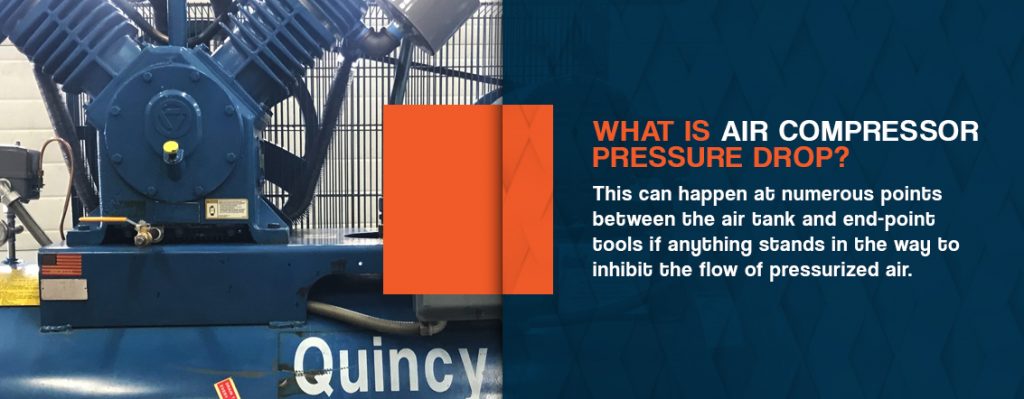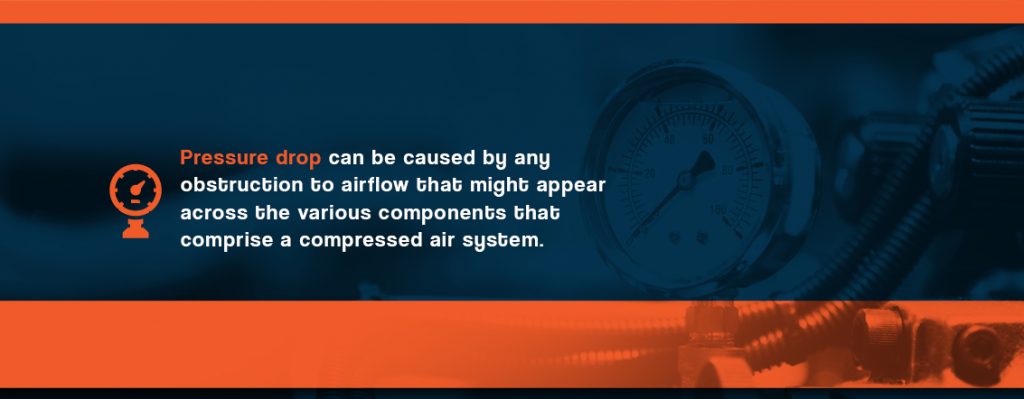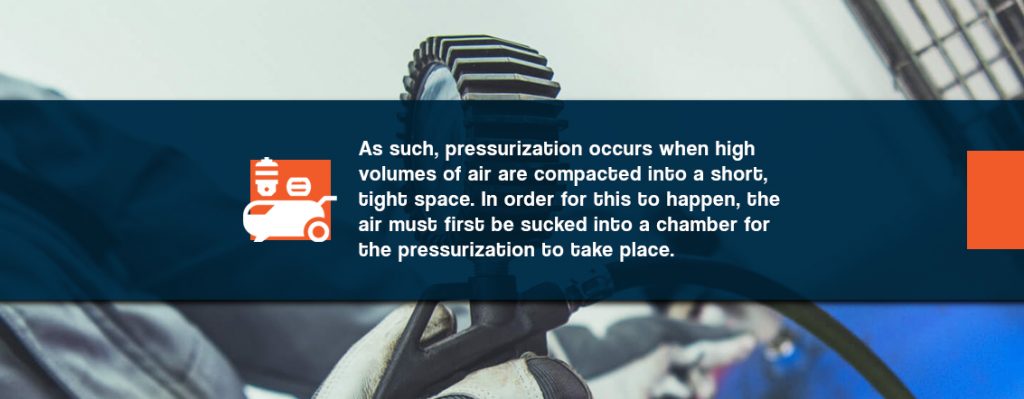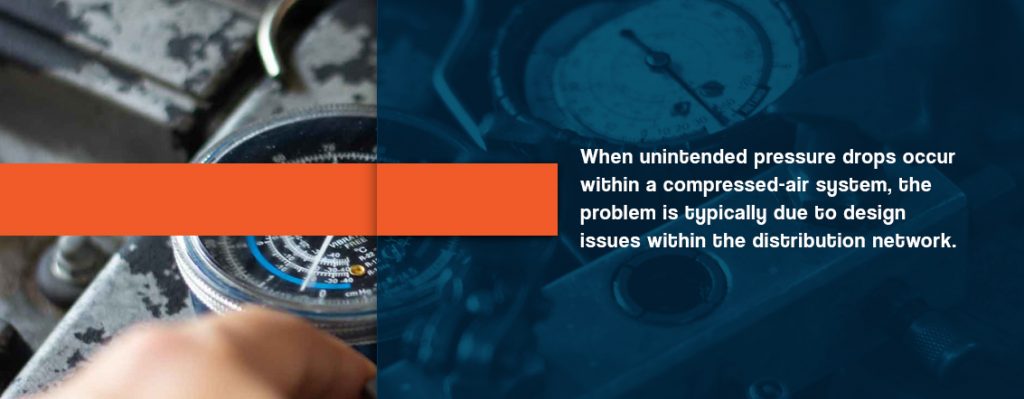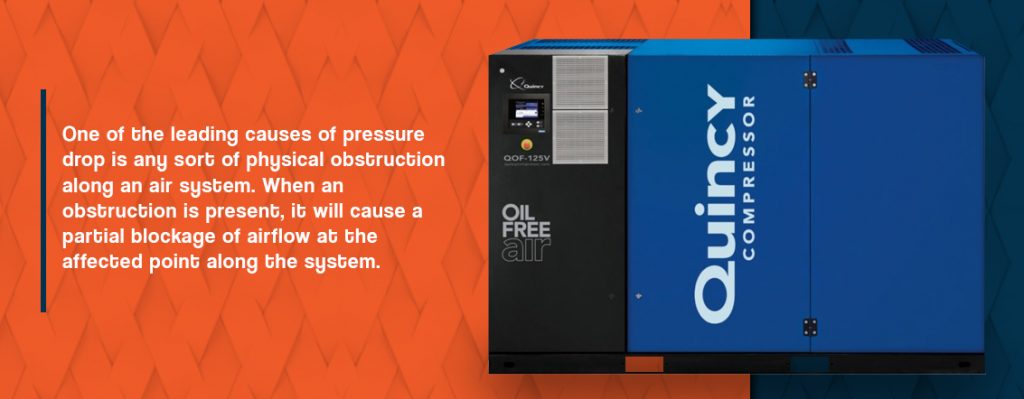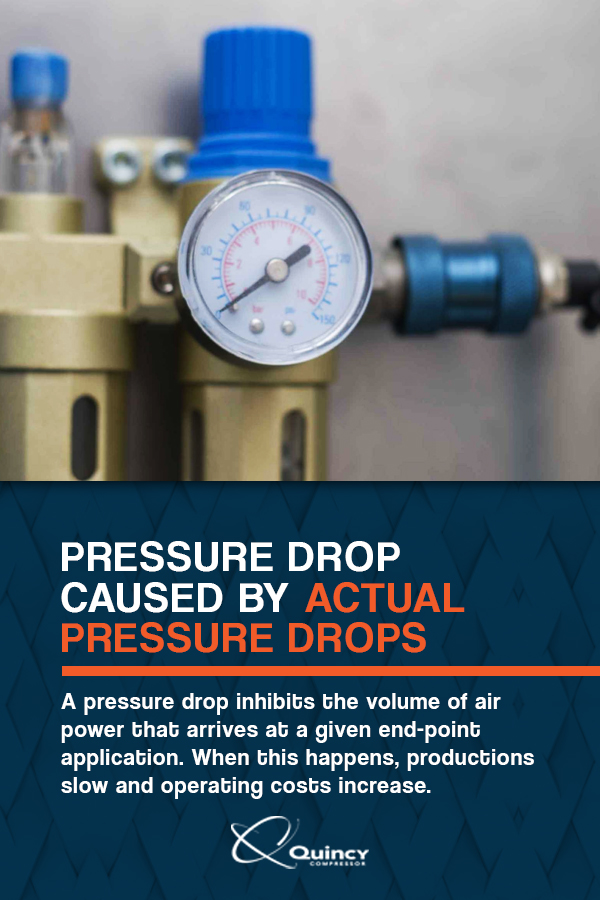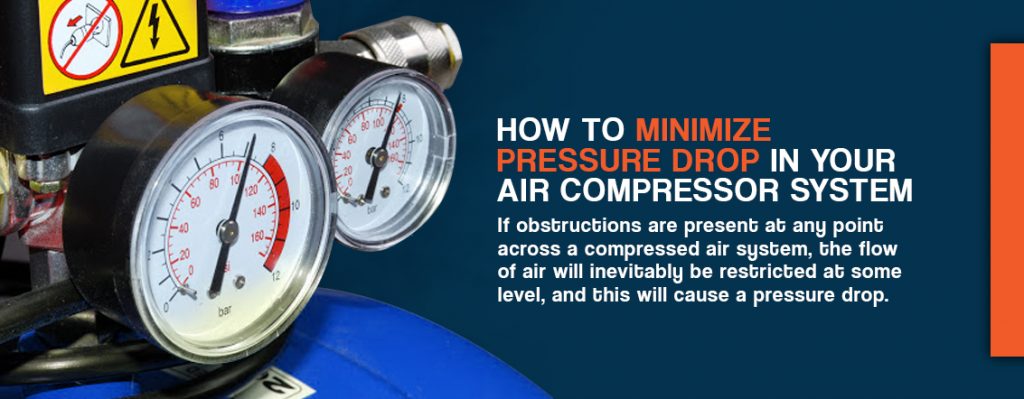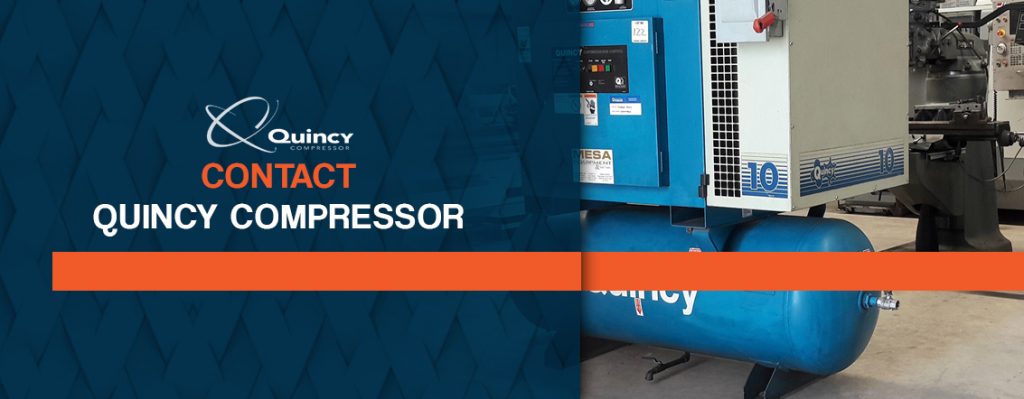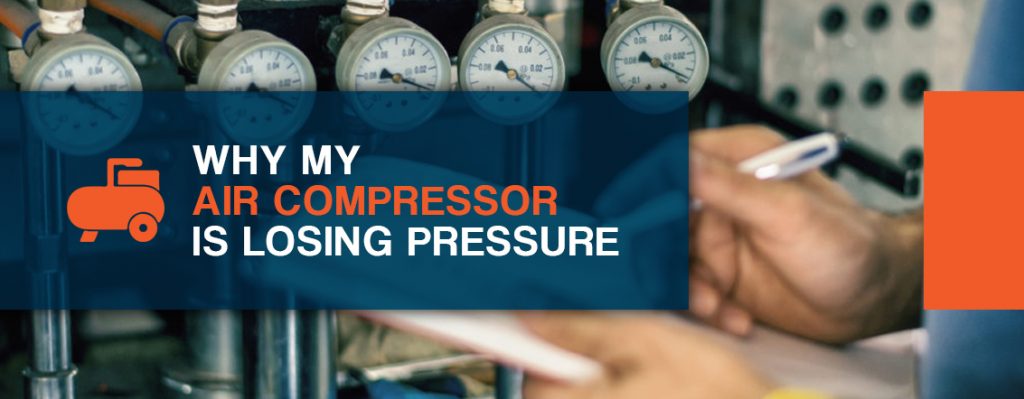
The U.S. Department of Energy estimates that industrial operations use 10% of their electricity on creating compressed air. As such, compressed air can be a costly investment. Inefficient production systems reduce profits, sometimes threatening the ongoing financial viability of businesses. With such intense price competition, manufacturers need to identify areas of inefficiency.
At industrial facilities, many unseen errors can cause reductions in air pressure between compressors and pneumatic devices. The phenomenon is known as pressure drop, which weakens the power of pressurized air supplies and renders applications less efficient. Learn more about pressure drop and how to minimize pressure and flow drop in air compressors.
Contact Us Learn More Find a Dealer Near You
What Is Air Compressor Pressure Drop?
Pressure drop refers to the instances when pressure loss occurs inside a compressed air system. This phenomenon can happen at numerous points between the air tank and end-point tools. Though it’s not possible to eliminate entirely, the problem should only account for a tiny fraction of your machine’s discharge pressure.
If your air compressor stops building pressure, you will see a drop in quality from the air-powered tools in your arsenal. When restrictions of flow take root, it takes increased amounts of energy to overcome the problem. If your system cannot yield sufficient air pressure under its normal operating power, the machine will strain itself just to compensate. It’s crucial to minimize these issues to keep your operations efficient and productive.
When pressure drop occurs, the problem is usually rooted in the after-cooler, check valves or lube separators. Each time the air compressor insists on more discharge pressure, more energy goes to waste. Increased pressure consumption results in further wasteful usage in other areas.
If you need more pressure at the end-point, make it your first priority to minimize pressure drop. Try to resist the urge to raise the machine’s capacity or boost pressure within the system. If you suppress the regulators to compensate for lost pressure, the regulators will become less responsive when needed in other areas, such as when leaks occur.
What Causes Air Pressure Drop?
Any airflow obstruction can cause pressure drop. If the airflow is restricted due to the presence of gunk in one of the passages, it could lead to a slight loss of air pressure between the unit and the end-point application. Some of the biggest pressure drops can be pinpointed to problems at the end-point. For example, if you have any leaks in a hose that connects to a pneumatic airbrush, you will inevitably lose some of the air pressure that your compressor generates.
At the other end of the system, issues might emerge with the separators or filters that could cause a loss of pressure. During times when the temperature is at its peak, and the pressurized air reaches maximum flow, you are likely to see the biggest losses of pressure. On systems where the regulator that handles the end-point pressure is unable to retain the necessary downstream pressure for the application at hand, the system overall would likely be listed as having excess levels of pressure loss.
Four causes of why your air compressor won’t build pressure include:
1. Inconsistent Air Pressure
Pressure is a measure of force per unit of area. Pressurization occurs when high volumes of air are compacted into a short, tight space. The pressurization can only occur when the air gets sucked into a chamber. The chamber must impose force on all sides, not allowing any air to escape.
In an air compressor, the enclosing forces that cause the pressurization of each incoming air supply are created by the walls of the internal chambers. In a rotary screw air compressor, these chambers house counter-rotating helical screws that squeeze the moisture from the air. In a reciprocating air compressor, these chambers house pistons that compact the air into a form of power.
The process will gradually lose its pressurization capabilities if the walls that contain the air lose their structural strength. If cracks or splits, however faint, start to form along these walls, each incoming air supply could be rendered less and less powerful by the time it passes to the end-point application. Basically, the integrity of the chamber that traps each incoming air supply is just as responsible for the power of the outgoing air as the screws and pistons that make the pressurization process possible.
The air that undergoes pressurization inside a compressor is referred to in scientific parlance as gas. While any form of matter that is neither liquid nor solid is technically referred to as gas, the gas compressed within an air compressor is actually ambient air from the machine’s surrounding environment.
To amass the amount of force and intensity required for pressurization, the process needs energy. Air compressors are designed to move energy from a central pressurization chamber to an end-point application, such as a pneumatic brush or sander. The energy put forth by a reciprocating or rotary screw air compressor is intended for use in a linked, adjacent area, where the air is ultimately released at the tip of a tool or within the process of an air-powered machine.
Pressure drop is an unintended consequence of the processes that turns ambient air into pressurized power. Even though pressure drop is undesired, it is inevitable to some degree in virtually any system. Pressure drop comes in two basic varieties: natural and unintended. The natural type of pressure drop is the small amount that will occur, regardless of the tightness and perfection of your system. Unintended pressure drop is the kind that results from flaws within your system that could possibly be rectified if you know how to pinpoint the source of the problem.
2. Design Factors
When unintended pressure drops occur within a compressed-air system, the problem is typically due to design issues within the distribution network. In physics, pressure is defined as a mechanical property. In many different scenarios, the problem will result from oversight on the part of warehouse managers. If the engineer in charge of planning fails to properly align and place the components of an air system, significant volumes of force could ultimately be lost by the time the pressurized air reaches the corresponding pneumatic tools.
If the system is designed to send air to several different areas across a factory floor, poor planning could result in certain areas receiving insufficient airpower for the tools and processes at hand. In many cases, poor system planning results from hastily laid out system components and rushed purchasing choices.
Even if you have the most technically perfect and properly arranged compressed-air system possible, there will inevitably be a certain degree of pressure loss. The Department of Energy advises that a properly designed system should have a pressure loss of much less than 10 percent from the compressor’s discharge to the point of use. However, you can never expect the issue of pressure drop to disappear entirely.
Pressure drop can occur when you add more pipes to a compressed air system. This is due to the fact that pressurization results from air being squeezed into compact spaces. Once the air passes to a larger area, it loses some of its pressure.
When you add space for the pressurized air to occupy, you increase the space’s volume. The more volume you allow for the air in a pressurized air system, the more pressure you need to retain the power of the compressed air. By adding more pipes to your system, you are increasing the number of avenues for the air to travel, hence reduced pressure. To avoid this pressure loss, you would need to have more pressure to account for the enlarged space. Otherwise, you are taking a supply of air that received x-amount of pressurization in a y-sized space and releasing it to a larger area.
You need to proportion pressure and volume to achieve sufficient air power for all work applications. Calculating pressure levels for every system lets you identify these measurements. You will not arrive at an accurate calculation if you merely add up all the usage expectations of the various applications because that would fail to take into account the potential for pressure drop along each path.
3. Air Compressor Blockages
One of the leading causes of pressure drop is any sort of physical obstruction along an air system. When an obstruction is present, it causes a partial blockage of airflow at the affected point along the system. The blockage might only inhibit a small part of the overall flow, but this can still result in major pressure loss. Obstructions rarely cause complete stops in airflow.
Pressure intensifies in front of an obstruction and then drops significantly as the air passes. When you investigate the root of such a problem, this spot of intensity can make it easy to pinpoint the obstruction.
Obstructions are sometimes unintentionally built into a system. If your pipes and connectors are fastened to walls, there might be metal bolts that partially intrude into some of these pipes. Even if the metal barely penetrates the interior of the pipe, it will still reduce the diameter at the point of the air system.
Obstructions can also be caused by valves in an air system. As the air passes through a valve and makes a turn, there will inevitably be a slight change in pressure due to the interruption of flow momentum. Some of the equipment that you might use to monitor your system could also cause reductions in air pressure. Examples include inline sensors and gauges, which can affect air pressure merely by making contact with the pipes and connectors.
The one system part that gradually loses its ability to do its intended job is the filter. While filters are put in place to block out particulates that could contaminate pressurized air and impede its flow, the filters eventually become clogged with dust and dirt. Once the filters become too dirty, the inlet valves draw less and less air into the compressor, thus robbing your system of new air to pressurize. Granted, clean filters can also account for small amounts of resistance, but dirty filters will gradually impede the process of your air compressor.
4. Pressure Drop Caused by Actual Pressure Drops
Production managers operating inefficient compressed air systems are subjected to their own forms of pressure — time and cost constraints. Every one PSI of excess operating pressure increases air compressor power consumption by about 0.5 percent. So, taking emergency measures without examining your current layout will just worsen cost and output performance.
A pressure drop inhibits the volume of air power that arrives at a given end-point application. When this happens, productions slow and operating costs increase. When managers get wind of these situations, a common reaction is to simply turn up the power to intensify the pressure that reaches each pneumatic application. Such an action could be a hasty error in judgment that would only drive up your costs even further and ultimately lead to system damage and a premature need for costly new parts.
When you overload a system with excessive volumes of pressure, the effects could be damaging and possibly disastrous, especially if you allow the situation to continue unchecked for a period of time. Excessive pressure loads are most damaging to the connecting points in a compressed air system, such as the valves and contacts.
For example, if too much air pressure is forced into a pipe, the pressure could over-stress the connecting point where the pipe begins and result in air leaks. As the overload persists and the component gets even weaker, the pressure could ultimately cause a rupture and render the parts unusable.
Many operators assume leaks cause most pressure drops, but they often come from other sources. Inappropriate pipe gauges, overextended pipe runs, bends, pipe interior irregularities, blockages and dirty filters usually create pressure drops. The leaks resulted from overloading, which was a reaction to an unacceptable pressure drop. If you only hunt for leaks, you are looking for the symptoms of your compressed air system problems, not the cause. Detecting leaks will provide evidence of failure. Get them replaced, but then move on to plan a long-term, cost-effective solution to your pressure drop headaches.
How to Calculate Pressure Drop
The standard compressed air pressure drop equation for calculating the likely pressure difference between the compressor and the user is known as the “empirical formula.” This formula is:
dp = 7.57 q1.85L 104 / (d5p)
The factors represented by the letters in that formula are as follows:
- dp: The drop in pressure, measured in kg/cm2.
- q: The volume flow of air, measured in m3/min.
- L: The pipe length, measured in meters (m).
- d: The diameter of the inside of the pipe, measured in millimeters (mm).
- p: The total starting pressure, measured in (kg/cm2).
Despite the math behind this formula, a lot of warehouse managers are put off by its complexities. Consequently, the common practice is to crank the pressure on an air compressor and wait for the pneumatic tools to receive the proper intensities of air pressure. Therein lays the problem that has rendered so many factory operations inefficient when it comes to energy use; when you turn up the pressure to compensate for the loss, you increase the pressure drop and consume excessive amounts of energy. Thus, factory operations become costlier and less productive.
Distribution Problems
Despite its apparent surface complications, the mathematical formula for calculating pressure drop is based on simple compressor-to-pipe arrangements. The formula does not take into account the possibility of bends along the piping of a compressor system. Another factor that the formula does not take into consideration is the possibility of flow reduction within an air pipe. The interior surface of a tube and the way that the pipe is laid across an air system can both be causes of turbulence during air-powered operations.
Compressor operators often assume that air always travels in a forward direction within the attached pipes, but this is sometimes not the case. Across the layout of air pipes in a system, energy can go to waste as the flow of air is interrupted or set astray by bends and kinks in the piping. At each point along the system where air is misdirected, energy is consumed by these unproductive movements. If the bends are small and elusive to the naked eye, it can be hard to measure the directional flow in a compressed air system.
Whether the air flows in a straight line or not is determined by a factor called the Reynolds number. That factor is derived through the formula:
Re = ρvd/µ
The meanings of these symbols are as follows:
- Re: The Reynolds number
- ρ: The density of the air
- v: The mean of the velocity
- d: The pipe diameter
- µ: The dynamic viscosity
Once you have the Reynolds number, you are then able to decide whether your air flow is efficient. Air flowing in a straight line is called “laminar flow.” When air is following a convoluted path, it is in a “turbulent flow.” You can label your flow as laminar if your observations resulted in a number lower than 2,300. If it’s higher than 3000, you have turbulent flow.
You might decide to skip the effort of calculating the Reynolds number and just turn up the compressor. This is a common mistake and introduces much greater inefficiency into your power usage. This is because turbulence creates resistance in the flow. Resistance slows down the flow rate and causes a drop in pressure.
You probably think that increasing the pressure in your piping system will ram through the air at a faster speed and overwhelm turbulence. The opposite is true. Higher pressure actually increases turbulence, so overcoming the problem by brute force is not a viable option.
How to Minimize Pressure Drop in Your Air Compressor System
If your air compressor loses pressure quickly, it’s vital to fix it as soon as possible. You can resolve pressure loss with many methods, including these strategies:
1. Optimize Air Compressor Design
Obstructions at any point in a compressed air system can cause obstructed air flow, resulting in pressure drops. You can adjust your air compressor design to minimize potential obstructions.
When you select air compressor parts like after-coolers, filters, dryers and separators, you should pick options that minimize pressure drop. The parts should be able to handle intense applications and temperatures with minimal pressure loss. After you install these components into your system, follow the recommended maintenance processes:
- Organize the distribution system carefully to prevent folds, bends and leaks.
- Minimize the presence of moisture within the pipes by cleaning the filters and dryers on a regular basis.
- Shorten the length of the distribution system. Even if every part is in perfect operating condition, the system loses performance ability when the air has to pass through endless tubes and connectors. When you have less distance for the air to travel, you can reduce the possibility and intensity of pressure along the path between the air compressor and the end-point application.
- Determine which pressure regulators yield the lowest differential. Do the same with the hoses and lubricators. Size these parts for the true flow rate, as opposed to the average flow rate.
2. Conduct Thorough Air Compressor Inspections
If you notice pressure drops during compressor performance, inspect the unit carefully for issues. Check the following parts:
- Hoses: Air leaks can form and cause pressure loss when ruptures appear on the hoses that connect your compressor and assorted pneumatic tools.
- Tubes: Cracks can also form on the tubes that connect to your air compressor.
- Couplings: Loose couplings can lead to air loss and pressure drops. This can be especially costly, even if the looseness is slight.
- Piping trees: The parts of your system where airflow is funneled into two streams can be vulnerable to air leaks.
- Elbow: All the connecting points could render your system vulnerable to pressure loss, including elbow connectors.
- Filters: The filters that block dust from entering your system will gradually become clogged, which makes it necessary to check these parts on a regular basis.
- Regulators: The passage of air across your system is controlled by the regulators, which must perform without fail at all times.
- Valves: The valves must be tightly fasted to prevent the possibility of air leaks.
- Nozzles: Any system part that features a nozzle could have an air leak in this place if the nozzle is not securely fastened.
- Lubricators: Make sure that the lubricating component is fully functioning.
3. Replace Faulty Parts
If you notice problem areas during your inspection, you should replace these parts as soon as possible to reduce pressure drops. Common replacements include:
- Piping: Many air compression systems contain piping between the compressor and other tools. You should check these pipes regularly and replace them if you notice signs of wear. Make sure each one is secure and airtight, with proper sealing at both ends. Analyze the pipe’s entire length for kinks, folds, tears or holes, and ensure it hasn’t formed rust, which slowly degrades quality and creates pressure drops. If you notice any of these signs, install new piping.
- Pipe connectors: These connective components can also result in pressure drops if not functioning correctly, making replacements essential. During inspections, check each pipe connector for signs of leaks or looseness. Replace any loose or improper fits with correctly sized parts. Improper sizes can split airflow, creating significant pressure losses. Removing complex connecting points and rewiring them with a more straightforward structure can also minimize connector issues.
- Filters: Compressor filters are crucial for airflow. Dirt and dust land on filters and impair their operating ability. You should clean filters consistently and monitor their condition. If they become too clogged or dirty to function properly, replace them as soon as possible. Inspect each filter at least once a week for the best results.
- After-cooler: If your after-cooler loses its ability to regulate system temperatures, you should replace it immediately. Purchase a new after-cooler with the lowest possible pressure drop for your compressor. That way, your compressor can handle high-intensity operations without straining the system.
- Separators: Your air compressor’s separators filter moisture from air streams. They also extract oil from pressurized air before it reaches the hoses. If you notice these processes aren’t completed properly, you should replace the separators.
- Dryers: Dryers keep moisture levels as low as possible. Without a dryer, your compressor’s air won’t receive sufficient pressure as it exits the system. Malfunctioning dryers might also facilitate rust formation, harming interior components. Replace faulty dryers with newer units that have the lowest possible pressure drops at maximum operating conditions.
- Lubricators: Compressed air systems require properly sized lubricators that match the system’s flow rate. Replace your current lubricators if they perform incorrectly or can’t support the system’s loads. Install lubricators with ratings for maximum pressure drop reduction for optimal results.
Benefits of Monitoring and Minimizing Air Pressure Drops
You can see significant improvements across your air compression system after reducing pressure drops. These are a few benefits of the process:
- Improved performance: Consistent airflow allows systems to function quickly and efficiently. With minimal pressure drops, you can experience fewer instances of system downtime and costly replacements.
- Reduced maintenance: Many processes that minimize air pressure drops benefit the entire air compression system. These beneficial practices reduce overall maintenance requirements. For instance, regular checkups give you a clearer view of your system’s health. You can notice problems before they grow more severe and require expensive repairs.
- Lower operating costs: When the compressed air system operates more efficiently, it takes less time to complete tasks. You use less energy and experience low operating costs as a result. In addition, lowered maintenance requirements keep regular expenses minimal.
- Reduced environmental impact: The less energy your system uses, the less impact it has on the environment. It releases fewer gases into the air, creating a healthier working environment for workers. Reduced energy also minimizes your carbon footprint.
- Improved brand image: As you enhance productivity and increase environmentally friendly practices, you can improve your overall brand image for consumers.
Contact Quincy Compressor
Learning how to stop air compressor pressure drop can be a complicated process. To diagnose and effectively eliminate pressure drop, you should conduct thorough inspections of your compressed air system. Licensed professionals provide the ultimate accuracy for sizing calculations, helping you optimize your air compressor use.
At Quincy Compressor, our team of service techs is known throughout the industrial sector for our attention to detail and dedication to quality. For the past century, we have been the world’s leading innovator in compressed air technology. With our arsenal of tools and equipment and our pool of technical expertise, we can examine the performance of your compressed air system and make improvements that will greatly improve its efficiency.
Contact Quincy Compressor to find out how we can help you. We can send a sales or service rep to visit your site, or you can drop in to one of our service centers for a quick chat. Find your nearest authorized Quincy Sales and Service Center through our Sales and Service Locator. Reduce the pressure on yourself, and then get rid of air pressure drops in your manufacturing facility. Deal with your compressed air system faults today before they overwhelm your company’s viability.
Contact Us Learn More Find a Dealer Near You
Last Updated on June 30, 2023 at 8:00 am


